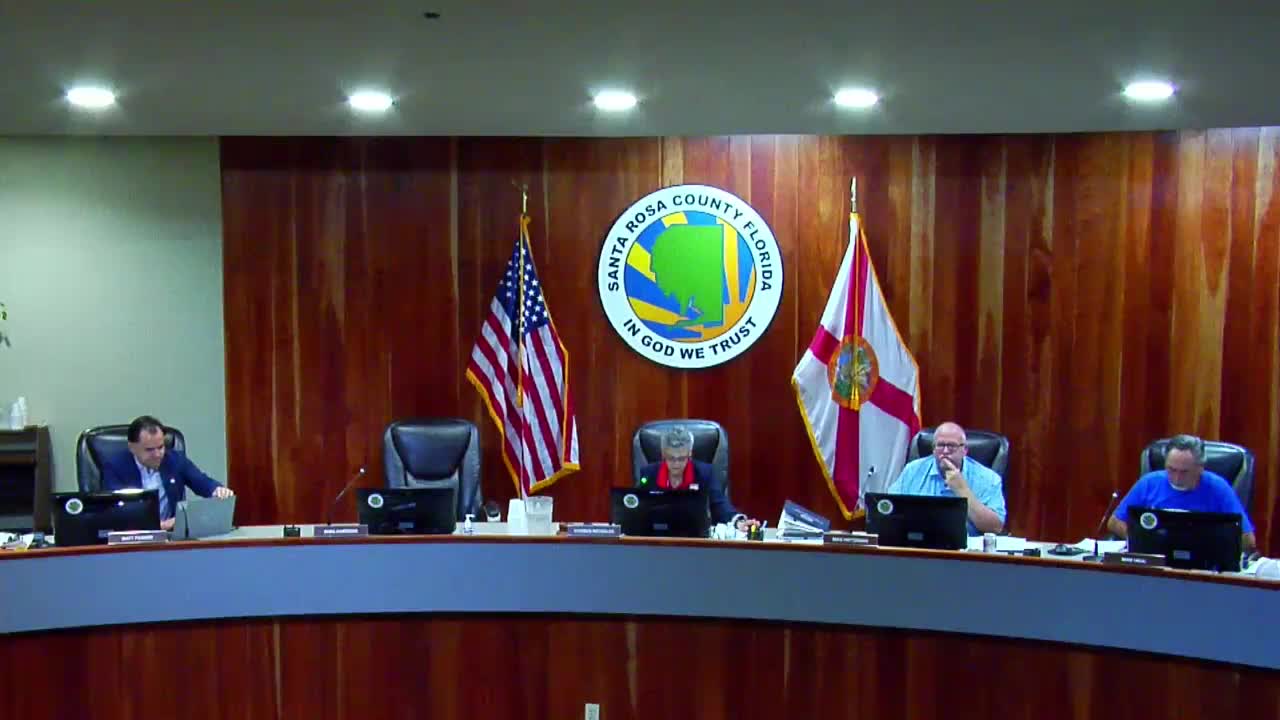Residents press task force to curb clear‑cutting; engineers and builders explain when filling and cutting are required
April 20, 2025 | Santa Rosa County, Florida
This article was created by AI summarizing key points discussed. AI makes mistakes, so for full details and context, please refer to the video of the full meeting. Please report any errors so we can fix them. Report an error »

Several Santa Rosa County residents used the May 2 task force meeting to urge tight limits on clear‑cutting and stronger wetland protections, saying clear removal of trees harms wildlife, increases runoff and damages the character of rural neighborhoods.
Public commenters suggested a 100‑foot wetland buffer (citing Okaloosa County as an example), called for updated rainfall data for pond design, and warned that conservation language should not be a veneer for later development. "We are not against growth. We just want better. Better planning, better transparency, better accountability," said Cindy Smith, a Pace resident who told the task force she reviewed developer requests and county decisions and saw patterns she found troubling.
Technical experts and developers provided engineering context. Tom Hammond, a subdivision designer invited by staff, said some South Santa Rosa County parcels have a high seasonal water table near grade; where roads must sit above that table engineers must bring in fill to protect the road subbase and prevent failures. "If you don't have 2 feet between your roadbed and the water table, your road will fail," planning staff and engineers emphasized during the discussion. Hammond described three common field approaches: (1) limit clearing to rights‑of‑way and build roads first, (2) import substantial fill when the water table is close to grade, or (3) use alternative foundation techniques on houses (stem‑wall foundations) and concentrated drainage solutions — each approach has cost and erosion tradeoffs.
Home builder Mike Patterson pointed to stem‑wall foundations as a tool that can reduce the amount of fill needed per lot but noted they add cost and time: he estimated a typical stem‑wall slab might cost roughly $1,600 more than a monolithic slab and may extend foundation construction from two weeks to months depending on topography. The group discussed techniques used by military construction and other counties: inward‑tucked silt fencing, hydroseed, staged clearing, and vegetated swales to reduce runoff and protect adjacent properties.
Task force members summarized the tension: many residents want to curb blanket clear‑cutting, but some areas (particularly in the south end) present engineering constraints that make some clearing and fill necessary to provide stable roads and stormwater systems. In response the group added a drafting direction asking staff to require an engineered grading plan, submitted to the county engineer and planning director, when a developer claims the clearing limit is infeasible. That plan must show drainage feasibility and infrastructure needs before additional clearing is permitted.
Ending: Staff agreed to include examples and engineering justification in the redline they will circulate before the next meeting, and to bring data on wetland buffers and updated rainfall design standards. Residents asked staff to publish permitting records and to consider stronger notification requirements if conservation communities or clustering provisions are applied near farms and established neighborhoods.
Public commenters suggested a 100‑foot wetland buffer (citing Okaloosa County as an example), called for updated rainfall data for pond design, and warned that conservation language should not be a veneer for later development. "We are not against growth. We just want better. Better planning, better transparency, better accountability," said Cindy Smith, a Pace resident who told the task force she reviewed developer requests and county decisions and saw patterns she found troubling.
Technical experts and developers provided engineering context. Tom Hammond, a subdivision designer invited by staff, said some South Santa Rosa County parcels have a high seasonal water table near grade; where roads must sit above that table engineers must bring in fill to protect the road subbase and prevent failures. "If you don't have 2 feet between your roadbed and the water table, your road will fail," planning staff and engineers emphasized during the discussion. Hammond described three common field approaches: (1) limit clearing to rights‑of‑way and build roads first, (2) import substantial fill when the water table is close to grade, or (3) use alternative foundation techniques on houses (stem‑wall foundations) and concentrated drainage solutions — each approach has cost and erosion tradeoffs.
Home builder Mike Patterson pointed to stem‑wall foundations as a tool that can reduce the amount of fill needed per lot but noted they add cost and time: he estimated a typical stem‑wall slab might cost roughly $1,600 more than a monolithic slab and may extend foundation construction from two weeks to months depending on topography. The group discussed techniques used by military construction and other counties: inward‑tucked silt fencing, hydroseed, staged clearing, and vegetated swales to reduce runoff and protect adjacent properties.
Task force members summarized the tension: many residents want to curb blanket clear‑cutting, but some areas (particularly in the south end) present engineering constraints that make some clearing and fill necessary to provide stable roads and stormwater systems. In response the group added a drafting direction asking staff to require an engineered grading plan, submitted to the county engineer and planning director, when a developer claims the clearing limit is infeasible. That plan must show drainage feasibility and infrastructure needs before additional clearing is permitted.
Ending: Staff agreed to include examples and engineering justification in the redline they will circulate before the next meeting, and to bring data on wetland buffers and updated rainfall design standards. Residents asked staff to publish permitting records and to consider stronger notification requirements if conservation communities or clustering provisions are applied near farms and established neighborhoods.
View full meeting
This article is based on a recent meeting—watch the full video and explore the complete transcript for deeper insights into the discussion.
View full meeting